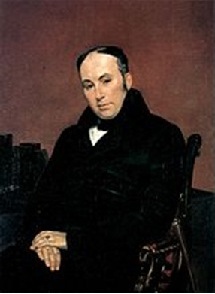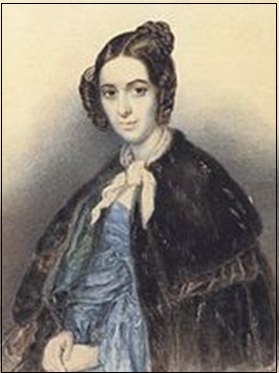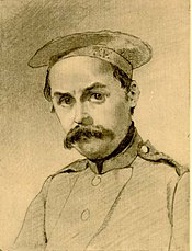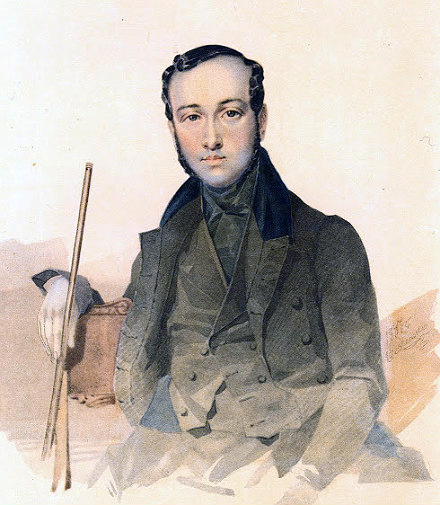The library informs
To the 208th anniversary of the birth of Taras Grigoryevich Shevchenko
Love your Ukraine.
To love її ... in time of fierceness,
In the rest, a hard minute
Pray the Lord for her.

Taras Grigorievich Shevchenko
(1814-1861)
Ukrainian poet, prose writer, thinker, painter, graphic artist, ethnographer, public figure.
Shevchenko's literary heritage, in which poetry plays a central role, in particular the collection "Kobzar", is considered the basis of modern Ukrainian literature and, in many respects, the literary Ukrainian language. Figure of the Ukrainian national movement, member of the Cyril and Methodius Brotherhood.Most of Shevchenko's prose (tales, diary, many letters), as well as some poems, are written in Russian, in connection with which some researchers attribute Shevchenko's work, in addition to Ukrainian, to Russian literature as well.
Childhood and youth
Taras Shevchenko was born on February 25 (March 9), 1814 in the village of Morintsy, Zvenigorod district, Kiev province (now Zvenigorod district, Cherkasy region, Ukraine). He was the third child of serfs Grigory Ivanov Shevchenko and Ekaterina Akimova Boyko - after his sister Ekaterina and brother Nikita. Their owner, V. V. Engelhardt, as the nephew of Prince G. A. Potemkin, inherited a significant part of his Little Russian possessions.
According to family legends, Taras's paternal grandfathers and great-grandfathers descended from a certain Cossack Andrei, who came from the Zaporizhian Sich at the beginning of the 18th century. His grandfather Akim Boyko on his mother's side was a migrant from the Carpathian region. Taras Shevchenko's grandfather from his father's side - Ivan Andreevich Shevchenko - lived 106 years.

Parents' hut in Kirillovka. Painter T.G. Shevchenko T.G. 1843.
In the autumn of 1822, Taras began to learn to read and write from the local deacon Sovgir. During this time, I got acquainted with the works of Grigory Skovoroda. In the period 1822-1828 he painted Horses. Soldiers” (drawing not found). On January 29, 1823, his older sister and nanny Ekaterina married Anton Krasitsky, a peasant from Zelenaya Dibrova. On August 20, 1823, mother Ekaterina died from hard work and poverty, and on October 7, 1823, her father married a second marriage to the widow Oksana Tereshchenko, who already had three children. She dealt harshly with non-native children, including little Taras.
On June 22, 1824, Taras's half-sister Maria was born - from the second marriage of Grigory Ivanovich. Taras was engaged in Chumat fishing with his father. Been to Zvenigorodka, Uman, Elisavetgrad. On March 21, 1825, Grigory Shevchenko died from hard labor in the corvee, and soon the stepmother returned with her three children to Morintsy. Taras went into the service of the deacon P.F. Bogorsky, who came from Kyiv. As a scholar-servant, Taras carried water, heated the school, served the deacon, read the psalter over the dead and continued his studies. At that time, Shevchenko got acquainted with some works of Ukrainian literature.
Unable to endure the bullying of Bogorsky, Taras ran away from him and began to look for a painting teacher in the surrounding villages. Feeling a great craving for painting, he worked for several days and "studied" painting with Deacon Ephraim (Lysyanka, Zvenigorod district). He also had painting teachers from the village of Stebleva, Kanevsky district, and from the village of Tarasovka, Zvenigorod district.

"Then I was thirteen years old ...". Painter I.S. Izhakevich. 1938-1939.
At the school of a deacon-teacher, Shevchenko learned to read and write, and from the painters he got acquainted with elementary drawing techniques. In the sixteenth year of his life, in 1829, he was among the servants of the new landowner P.V. Engelhardt - first as a cook, then as a servant - "Cossack". The passion for painting did not leave him.
During his stay in Vilna, Engelhardt noticed the abilities of Taras and gave him to study with the portrait painter Jan Rustem, a teacher at Vilna University. Shevchenko stayed in Vilna for about a year and a half, and with the move to St. Petersburg in early 1831, Engelhardt, intending to make his serf a house painter, sent him in 1832 to study with Vasily Shiryaev, a “various painting craftsman”. As an assistant to Shiryaev, Taras Shevchenko participated in the work on the murals of the St. Petersburg Bolshoi Theater.
In 1836, while sketching statues in the Summer Garden, Shevchenko met his fellow countryman artist I.M. Soshenko, who introduced Taras to the conference secretary of the Academy of Arts V.I. Grigorovich, as well as to the artists A. Venetsianov, K. Bryullov and the poet V. Zhukovsky.
Sympathy for the young man and recognition of the giftedness of the Little Russian serf by prominent figures of Russian culture played a decisive role in redeeming him from captivity. Far from immediately succeeded in persuading the landowner Engelhardt. The personal petition of the famous academician of painting Karl Bryullov only confirmed the landowner in his desire not to sell too cheap.
The care of the best representatives of Russian art and literature touched and encouraged Shevchenko, but the protracted negotiations with his owner plunged him into despondency. I. M. Soshenko suggested that his friends act without delay. It was decided to offer Engelhardt an unprecedented amount for the redemption of a serf. In April 1838, a lottery was held in the Anichkov Palace, in which Bryullov’s painting "V. A. Zhukovsky". The proceeds from the lottery went to ransom the serf Taras Shevchenko.

Portrait of the poet V. A. Zhukovsky. Painter Karl Bryullov. 1837-1838.
The poet wrote in his autobiography: Having previously agreed with my landowner, Zhukovsky asked Bryullov to paint a portrait of him in order to play him in a private lottery. The great Bryullov immediately agreed, and his portrait was ready. Zhukovsky, with the help of Count Vielgorsky, arranged a lottery of 2,500 rubles, and my freedom was bought at this price on April 22, 1838.

K. P. Bryullov, T. Shevchenko's mentor at the Academy of Arts
As a sign of special respect and deep gratitude to Zhukovsky, Shevchenko dedicated one of his largest works to him - the poem "Katerina". In the same year, Taras Shevchenko entered the Academy of Arts, where he became a student and friend of K. Bryullov. At the Academy he was awarded medals for his work (1839, 1840 and 1841), received the title of a free artist of painting for the painting "Gypsy" (1845).

Petersburg. Academy of Arts, where in 1838-1845. studied T. Shevchenko
The period in the life of the poet from 1840 to 1846
The period from 1840 to 1846 was the best in the life of the poet. At this time, his poetic talent flourished. The first and most famous collection of Shevchenko's poems in Ukrainian, "Kobzar", published in 1840, grew out of the romantic tradition of collecting folk songs (Ossian, Kirsha Danilov, "Songs of the Western Slavs"). From a romantic intoxication with the Cossack past, Shevchenko evolved towards a more sober view of national history, manifested in the poem Gaidamaki (1841), which celebrates the popular movement of the 18th century.
In 1842, "Gaidamaki" was published - his largest poetic work. In the first half of the 1840s, “Perebendia”, “Topol”, “Katerina”, “Naymichka”, “Khustochka”, “Kavkaz” were published - major poetic works of art.

Taras Shevchenko, self-portrait. 1840−1841 pp.
In 1842, "Katerina" was painted - the only surviving oil painting of the academic period. The picture was created on the theme of the artist's poem of the same name. Shevchenko tried to make the picture clear and understandable, to encourage sympathy. In 1844 he received the title of a free artist at the academy.
In 1843, Shevchenko received the degree of a free ("non-class") artist. In the same year, while traveling around Ukraine, he met the daughter of the Little Russian Governor-General N.G. Repnina - Varvara, a kind and intelligent woman who later, during Shevchenko's exile, had the warmest feelings for him.

Princess Varvara Repnina
In 1845, Shevchenko twice visited Pereyaslav with his friend, doctor A. O. Kozachkovsky (whom he met in 1841 in St. Petersburg): in August and from October to early January 1846. The fall of 1845, spent in Kozachkovsky's house, is considered by Shevchenko scholars to be the period of Shevchenko's genuine creative rise and is called the Kobzar's Pereyaslav autumn: it is here that he creates his works such as the poems "Naymichka" and "Caucasus", a dedication to Shafarik for the poem "Heretic", and in the night of December 25 - the famous "Testament" ("Zapovit"). In the poems "Caucasus" and "Heretic" the poet debunks not only the "dark kingdom" of autocracy, but also takes up arms against any violence against the human person from a universal standpoint.
By the time of Shevchenko's stay in Kyiv (1846), his rapprochement with N.I. Kostomarov. In the same year, Shevchenko joined the then-formed Cyril and Methodius Society in Kyiv, which consisted of young people who were interested in the development of the Slavic peoples, in particular the Ukrainian one. Members of this circle, including 10 people, were arrested, accused of creating a political organization and suffered various punishments. Although the investigation was unable to prove Shevchenko's involvement in the activities of the Cyril and Methodius Society, he was found guilty "for his own individual actions." In the report of the head of the Third Department A.F. Orlov said:
Shevchenko ... composed poems in the Little Russian language of the most outrageous content. In them, he sometimes expressed lamentation about the imaginary enslavement and disasters of Ukraine, then he proclaimed the glory of the hetman's rule and the former freemen of the Cossacks, then with incredible audacity he poured slander and bile on the persons of the imperial house, forgetting in them his personal benefactors. Shevchenko acquired among his friends the fame of a significant Little Russian writer, and therefore his poems are doubly harmful and dangerous.
By the decision of the Third Branch, approved by the Emperor himself, on May 30, 1847, 33-year-old Taras Grigorievich Shevchenko was assigned to military service as a private in the Separate Orenburg Corps, located in the Orenburg Territory, "under the strictest supervision of the authorities" with a ban on writing and drawing.
Military service in the Orenburg region

"In Soldiers". Self-portrait. 1847.
The Orsk fortress, where the recruit Shevchenko first got, was a desert outback. “Rarely,” Shevchenko wrote,“you can find such a spineless terrain. Flat and flat. The location is sad, monotonous, the lean rivers of the Ural Or, the bare gray mountains and the endless Kyrgyz steppe ... ". “All my previous suffering,” Shevchenko says in another letter from 1847,“compared to the present, there were children's tears. Bitter, unbearably bitter." For Shevchenko, the ban on writing and drawing was very painful; his severe ban on drawing was especially depressing. Not knowing Gogol personally, Shevchenko decided to write to him "by the right of a Little Russian verse-maker", in the hope of Gogol's Ukrainian sympathies. Shevchenko sent a touching letter to Zhukovsky asking him to apply for only one favor - the right to draw. Count A. I. Gudovich and Count A. K. Tolstoy worked for Shevchenko in this; but it proved impossible to help Shevchenko. In his request in an appeal to the head of the III department, General L.V. Dubelt, Shevchenko wrote that his brush had never sinned and would never sin in the political sense, but nothing helped. The ban on drawing was not lifted until the very end of the service. In 1848-1849, some consolation was given to him by participation in an expedition to study the Aral Sea. Thanks to the humane attitude towards the soldier of General Obruchev and, in particular, Lieutenant Butakov, Shevchenko was instructed to draw views of the Aral coast and local folk types for the expedition report.

Fortification of Raim. View from the shipyard on the Syr Darya.
Painter Shevchenko T. 1848.
However, this violation became known in St. Petersburg; Obruchev and Butakov were reprimanded, and Shevchenko was sent to a new desert slum - the military fortification of Novopetrovskoye in the Caspian Sea, with a second ban on painting. He was in Novopetrovsky from October 17, 1850 to August 2, 1857, that is, until the end of his service. The first three years of his stay in the "stinky barracks" were painful for him; then various reliefs followed, thanks mainly to the kindness of commandant Uskov and his wife, who fell in love with Shevchenko for his gentle nature and affection for their children. Not being able to draw, Shevchenko was engaged in modeling, tried to do photography, which, however, was very expensive at that time.
In Novopetrovsky Shevchenko wrote several stories in Russian - "The Princess", "The Artist", "Twins", containing many autobiographical details. During the service, Shevchenko became close friends with several of the educated Poles demoted to the soldiers Z. Serakovsky, B. Zalessky, E. Zhelikhovsky, which helped to strengthen the idea of \u200b\u200b“merging brothers of the same tribe” in him.
Petersburg period
The release of Shevchenko took place in 1857 thanks to persistent petitions for him by the vice-president of the Academy of Arts, Count F. P. Tolstoy and his wife, Countess A. I. Tolstaya. With long stops in Astrakhan and Nizhny Novgorod, Shevchenko returned along the Volga to St. Petersburg, and here, in freedom, he was completely carried away by poetry and art. Attempts to arrange a family hearth by marrying the actress Piunova, the peasant servants Harita and Lukerya, were not successful. Living in St. Petersburg (from March 27, 1858 to June 1859), Shevchenko was friendly received by the family of Count F. P. Tolstoy. Almost all of his time, free from numerous literary and artistic acquaintances, dinner parties and evenings, Shevchenko devoted to engraving.
In April 1859, Shevchenko, presenting some of his engravings to the discretion of the Council of the Academy of Arts, asked to be awarded the title of academician or to set a program for obtaining this title. On April 16, the council decided to recognize him as "appointed to academician and set up a program for the title of academician in copper engraving." On September 2, 1860, he was awarded the degree of academician in engraving "in respect of the art and knowledge of the arts."
Shortly before his death, Shevchenko took up the compilation of school textbooks for the people in the Ukrainian language.
He died in St. Petersburg on February 26 (March 10), 1861 from dropsy, caused, according to the historian N.I. Kostomarov, who saw him drinking, but only once drunk, "immoderate consumption of hot drinks."

Grave at the Smolensk Orthodox Cemetery in St. Petersburg
He was buried first at the Smolensk Orthodox cemetery in St. Petersburg, and after 58 days the coffin with the ashes of T.G. Shevchenko, in accordance with his Will, was transported to Ukraine and buried on Chernechi Mountain near Kanev. Funeral speeches were published in the magazine "Osnova" for March 1861.
Of the 47 years of his life, Shevchenko lived on the territory of modern Russia for 27 years: 1831-1845 and 1858-1861 in St. Petersburg, in 1847-1857 he served in the military in the Orenburg region. But wherever he was, he always remained the son of his land, remembered her and yearned for her, as for her mother. That is why Ukraine has become in the work of Shevchenko mainly fanned with love and longing.
Personal life of T.G. Shevchenko
The first love of young Shevchenko was Oksana, his age. Relatives and acquaintances of the lovers were sure that the young would get married as soon as they reached the appropriate age. But the hopes were in vain - Taras, in the roll of his master Pavel Engelhardt, was supposed to go to Vilna. The separation was unexpected and long. Throughout his life, Shevchenko remembered the girl he once loved.
The next girl he loved was the Vilna seamstress Dzhunya Gusikovskaya.
In 1843, Shevchenko went to Ukraine and met Varvara Repnina there, to whom he dedicated the poem "Trizna", as well as Anna Zakrevskaya, to whom he later dedicated the poem "G. Z."

Portrait of Zakrevskaya A.I. Painter Shevchenko T. 1843.
The next women who had a place in the heart of the poet were Agata Uskova, the wife of the commandant of the Novopetrovsky Fortification, Irakli Uskov, and 16-year-old actress Ekaterina Piunova, almost thirty years his junior.
The last love of the poet was the 19-year-old St. Petersburg laborer Likera Polusmakova, to whom Shevchenko dedicated the poems “Liquors”, “L. I will put a house and a room ... "
Shevchenko-artist
|
* Portrait of P.V. Engelhardt. 1833. |
* Portrait of E.P. Grebinka. 1837. |
* 1838. |
|
* Shevchenko T. "Maria". 1840. |
* 1840. |
* Shevchenko T. "Katerina". 1842. |
|
* Pochaev Lavra from the south. 1846. |
* Cathedral of St. Alexander in Kyiv. 1846. |
Shevchenko the writer
The poems of Taras Grigoryevich Shevchenko are an inexhaustible source of wisdom.
Written more than a century ago, Shevchenko's poetry is still relevant today.
Everyone should know the poems of Taras Grigoryevich Shevchenko, because "Kobzar" is the second Bible for Ukrainians. You unfold it, and: "Well, it would be a word ... Words, that voice - more than anything. And the heart beats - comes alive, how you feel it ... ". And Shevchenko's words are really special, in particular, because they are still relevant today.
Just such, far and inaccessible, is the image of Ukraine in the poem "Think of my thoughts ...".
 |
"Думи мої думи…".
Думи мої, думи мої, лихо мені з вами! За карії оченята, за чорнії брови За степи та за могили, що на Україні, (фрагмент)
|
Якби ви знали, паничі… Якби ви знали, паничі, За що, не знаю, називають Найперші сльози; я не знаю,
І, повиваючи, співала, А сестри! сестри! Горе вам, Ви в наймах виросли чужії,
Село Село! І серце одпочине... Цвітуть сади, біліють хати, А там і ліс – і ліс, і поле,
|
Сон Нa панщині пшеницю жала; пошкандибала
бо й сам
коло хати
Садок вишневий коло хати, |
У нашім раї на землі У нашім раї на землі
Зоре моя вечірняя Зоре моя вечірняя,
Встала весна Встала весна, чорну землю І на полі жайворонок,
|
Memory of Shevchenko
The perpetuation of Taras Shevchenko began soon after his death. The first monument to Taras Shevchenko was erected on the initiative and at the expense of Alexei Alchevsky in Kharkov in 1898 (according to other sources, back in 1881 in Fort-Aleksandrovsky by the former commandant and close friend of Shevchenko Irakli Uskov).
On the occasion of the 100th anniversary of Taras Grigoryevich Shevchenko in 1914, the first public celebration of the anniversary “Great Movement” took place in Lviv.
However, the modern mass perpetuation of the memory of the “kobzar” on both sides of the old border gained momentum after the October Revolution. Outside the Soviet Union, monuments to Shevchenko were erected on the initiative and at the expense of the Ukrainian diaspora, and after 1991 - also as gifts from the Ukrainian state (including in exchange).
Of the biopic films, the most famous is the 1951 film "Taras Shevchenko" with Sergei Bondarchuk in the title role.
When the 200th anniversary of Taras Shevchenko was celebrated, journalists counted 1060 monuments to Shevchenko and objects named after him. They are located in 32 countries on different continents. In particular, the Kazakh cities of Fort Shevchenko and Aktau received the name of Shevchenko in Soviet times.

Celebration of the 200th anniversary of the birth of T.G. Shevchenko
near Kiev University, named after him.
On the territory of the former USSR there are a dozen museums in memory of Shevchenko, the largest of which is the Shevchenko National Reserve in Kaniv.
Shevchenko National Reserve in Kanev.

Kanev. Monument to the great "Kobzar".
|
Grave and monument to Shevchenko T.G. on Tarasova mountain. |
The hut of the poet Taras Shevchenko. |
Monuments Shevchenko T.G. in Dnipro
 **
** 
1. The monument to the great Ukrainian poet Taras Grigoryevich Shevchenko was erected in Dnepropetrovsk in 1959.
The monument is located in the park named after Taras Grigoryevich Shevchenko, on the territory of the Monastery Island.
2. A monument to the great Ukrainian poet Taras Grigoryevich Shevchenko was erected in Dnepropetrovsk on the street. Lenin in 1992.
W i l l
Not a single poem in Ukrainian has received such wide recognition in the world as "Testament" by Taras Grigoryevich Shevchenko. The work is imbued with the desire to see a beautiful person on a beautiful earth. The poet believes that Ukraine will become independent, people will see clearly, and lies will be destroyed.
Заповіт
Як умру, то поховайте мене на могилі,
Серед степу широкого, на Вкраїні милій,
Щоб лани широкополі, і Дніпро, і кручі
Було видно, було чути, як реве ревучий.
Як понесе з України у синєє море
Кров ворожу... отойді я і лани, і гори —
Все покину і полину до самого бога
Молитися... а до того я не знаю бога.
Поховайте та вставайте, кайдани порвіте
І вражою злою кров'ю волю окропіте.
І мене в сем'ї великій, в сем'ї вольній, новій,
Не забудьте пом'янути незлим тихим словом.
And we must justify his aspirations, overcome all the difficulties on the way of our country to a happy future.
Let his "Testament" become our quide.
Library administration
2022
Information












